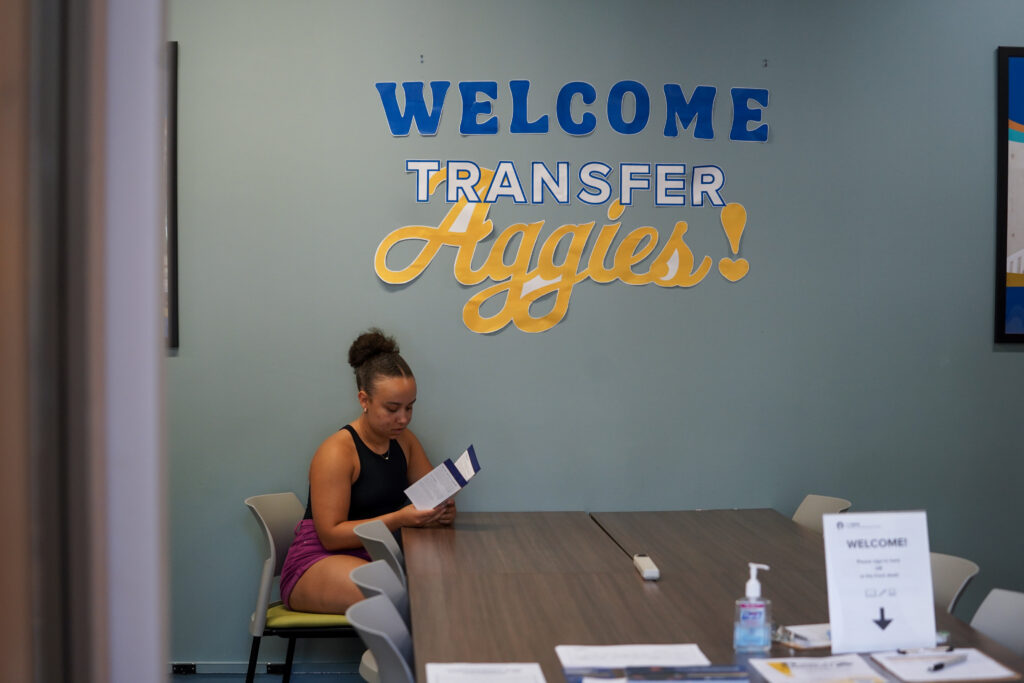
The Transfer and Reentry Center in Dutton Hall at UC Davis helps transfers get acclimated to their new environment.
Credit: Karin Higgins/UC Davis
Few students who intend to transfer from California’s community colleges do so successfully. To reverse that trend, the state’s public college systems will need to work collaboratively.
That’s the finding of a report released Tuesday by the California State Auditor, which, at the direction of the state Assembly’s Joint Legislative Audit Committee, examined the state’s community college transfer system.
Only about 1 in 5 students who entered community college between 2017 and 2019 and intended to transfer did so within four years, the audit found. Rates were even lower for Black and Latino students, as well as for students from certain regions of the state, including the Central Valley.
Many students struggled to navigate what critics call a complex transfer system in California, with variations in transfer requirements across the University of California and California State University systems, the audit found.
The report recommends that UC and CSU work with the community college system to streamline the transfer process. UC should consider widely adopting the associate degree for transfer (ADT) model that is already in place at CSU, and the systems should also share more data, according to the audit’s recommendations. The Legislature could also step in and appropriate funding to help CSU and UC better align their transfer requirements.
Complexity leads to low transfer rates
Students wishing to transfer often face obstacles that prevent them from getting to a four-year university. If students are considering multiple four-year universities for transfer, that often means a different set of requirements for each.
For example, the auditor reviewed six potential four-year campuses to which a community college student studying computer science could transfer: UC Berkeley, UC Santa Barbara, UC San Diego, CSU San Marcos, San Diego State and Stanislaus State.
The course requirements vary greatly across the four-year campuses. UC San Diego and San Diego State require potential transfer students to complete a course in intermediate computer programming, whereas the other four campuses do not. UC San Diego is also the only campus to require an additional calculus course. Meanwhile, that campus does not require students to take differential equations, but UC Berkeley and UC Santa Barbara do.
The audit calls out the ADT as a promising model at CSU, but even that has shortcomings, the report notes. The ADT, created in 2010, is a two-year degree that is no more than 60 credits and is fully transferable to CSU.
Although completing the ADT guarantees a student admission into CSU, it does not guarantee students admission to a specific major campus. That’s a problem, the audit notes, because transfer-intending students are more likely to enroll if they’re admitted to their preferred program.
UC, meanwhile, has not adopted the ADT at all and instead relies on its own transfer programs, such as the transfer admission guarantee. That program does admit students to specific campuses and majors, but not all campuses participate in the program, and for those that do, some majors are excluded. UC’s three most selective campuses — Berkeley, Los Angeles and San Diego — are the three that do not offer the transfer admission guarantee.
Among the transfer-intending students who entered community college between 2017 and 2019, 21% transferred within four years and less than 30% did so within six years.
Among Black students, between 16.1% and about 17.3% successfully transferred within four years for each cohort. For Latino students, between 14.5% and 15.6% in each cohort transferred in that time frame. That compares to more than 28% of white students in each cohort and as many as 30% of Asian students.
There were also differences depending on a student’s location.
The audit found that community colleges in the San Francisco Bay Area and San Diego regions, for example, had higher transfer rates than colleges in the Central Valley, Inland Empire and northern parts of the state.
“One factor contributing to this difference may be the distances between community colleges and CSU and UC campuses in those regions. Students are more likely to transfer to a nearby university for a variety of reasons, including challenges associated with relocating,” the audit states.
That’s true for students at Lassen Community College in northeastern California, according to an administrator there. The administrator told auditors that “proximity is a major barrier” for transfer-intending students. The closest CSU or UC campus is Chico State, which is still more than a two-hour drive. In fact, about three-quarters of students who did transfer from Lassen went to an out-of-state university.
Streamlining transfer
The report offers several recommendations to lawmakers and the public college systems that could streamline the transfer process.
Auditors recommend that lawmakers consider providing funding to the colleges to align requirements and make the ADT more widely accepted across the state.
The community colleges and the four-year systems could also do their part to improve the ADT. For the community colleges, that means analyzing why certain community colleges don’t offer the ADT for some majors. CSU, auditors recommend, should do the same for campuses that don’t accept the ADT for certain majors and then determine whether their reasons make sense.
UC should either widely adopt the ADT model or, for campuses unwilling to do that, ensure that their transfer options “emulate the ADT’s key benefits for streamlining course requirements,” auditors say. Last year, Gov. Gavin Newsom did sign Assembly Bill 1291 to create a pilot program at UCLA in which students beginning in 2026-27 will get priority admission if they complete an associate degree in select majors. The pilot will eventually expand to more campuses, though some students and advocacy groups criticized the legislation because it won’t guarantee students admission to their chosen campus.
The audit also recommends better data-sharing between the three systems.
The community college system could share data with UC and CSU about students who intend to transfer, which UC and CSU could use to better tailor their advice to those students.
Additionally, UC and CSU could share more data with the community colleges about the students who successfully transfer, which could help the community colleges better evaluate their transfer efforts and determine which ones are most effective.
Sonya Christian, chancellor of the community college system, said in a letter responding to the audit that the system looks forward to working with UC, CSU and lawmakers to implement the report’s recommendations, but said there could be challenges, including with data-sharing.
Christian said consistent and timely data remains a “persistent challenge” for the system because of its decentralized nature, which requires each of the 73 local community college districts to individually report data to Christian’s office.
“The lack of a common data platform hampers our ability to collect timely and reliable data on transfer rates and gaps and hinders our ability to be able to accelerate transfer for the students of California through real-time data sharing with four-year system and institutional partners,” she said.
But, Christian added, she has made it a priority since becoming chancellor last year to improve those processes and “let the data flow.”
“I look forward to carrying forward recommendations around improvements to our data, research, and system-wide policy leadership,” she added.





